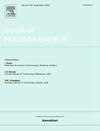Experimental study on the release of fission gas from defective cladding of PWR based on steady-state escape rate coefficient
IF 2.3
3区 工程技术
Q1 NUCLEAR SCIENCE & TECHNOLOGY
引用次数: 0
Abstract
This study experimentally investigates the release behavior of fission gas through cladding defects in a pressurized water reactor, utilizing non-radioactive krypton as a surrogate for radioactive fission products. The results demonstrate a transient-to-steady evolution of gas release rates, characterized by an initial rapid surge followed by gradual decay to equilibrium. Minor defects tend to exhibit extended transient phases as a result of limited gas flux, whereas larger defects are characterized by elevated peak release rates along with abbreviated transient phases. Elevated temperature and pressure enhance peak release rates through intensified phase transitions. This process is modeled through a first-order kinetic equation incorporating the steady-state escape coefficient (). This coefficient is estimated via the Chapman-Enskog diffusion equation. Both experimental and theoretical results indicate that is in the order of 10−9 to 10−8 s−1 for micrometer defects.
基于稳态逸出率系数的压水堆缺陷包壳裂变气体释放实验研究
本研究利用非放射性氪作为放射性裂变产物的替代物,实验研究了压水反应堆中裂变气体通过包层缺陷的释放行为。结果表明,气体释放速率从瞬态到稳定的演化,其特征是最初的快速激增,然后逐渐衰减到平衡。由于气体通量有限,较小的缺陷往往表现出延长的瞬态相,而较大的缺陷的特征是峰值释放率升高以及瞬态相缩短。升高的温度和压力通过强化相变提高峰值释放率。这一过程通过包含稳态逸出系数(ε)的一阶动力学方程来模拟。该系数通过Chapman-Enskog扩散方程估计。实验和理论结果均表明,微米级缺陷的ε值为10−9 ~ 10−8 s−1。
本文章由计算机程序翻译,如有差异,请以英文原文为准。
求助全文
约1分钟内获得全文
求助全文
来源期刊

Annals of Nuclear Energy
工程技术-核科学技术
CiteScore
4.30
自引率
21.10%
发文量
632
审稿时长
7.3 months
期刊介绍:
Annals of Nuclear Energy provides an international medium for the communication of original research, ideas and developments in all areas of the field of nuclear energy science and technology. Its scope embraces nuclear fuel reserves, fuel cycles and cost, materials, processing, system and component technology (fission only), design and optimization, direct conversion of nuclear energy sources, environmental control, reactor physics, heat transfer and fluid dynamics, structural analysis, fuel management, future developments, nuclear fuel and safety, nuclear aerosol, neutron physics, computer technology (both software and hardware), risk assessment, radioactive waste disposal and reactor thermal hydraulics. Papers submitted to Annals need to demonstrate a clear link to nuclear power generation/nuclear engineering. Papers which deal with pure nuclear physics, pure health physics, imaging, or attenuation and shielding properties of concretes and various geological materials are not within the scope of the journal. Also, papers that deal with policy or economics are not within the scope of the journal.
 求助内容:
求助内容: 应助结果提醒方式:
应助结果提醒方式:


